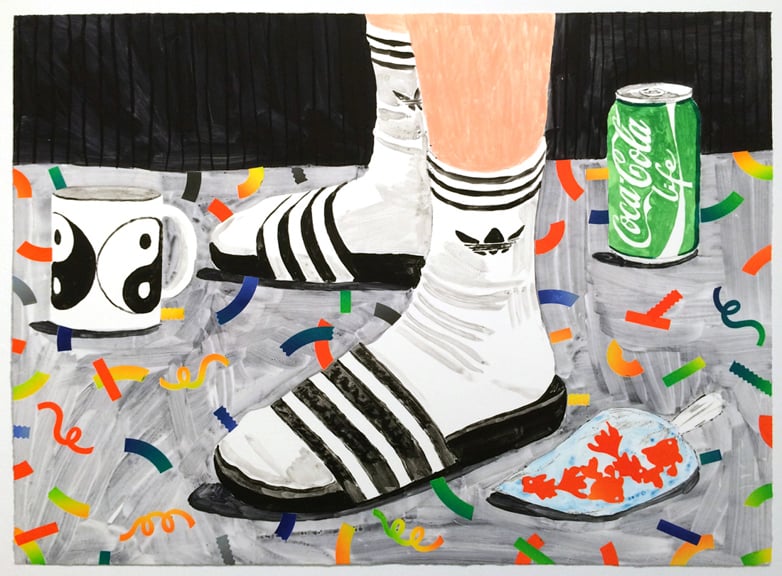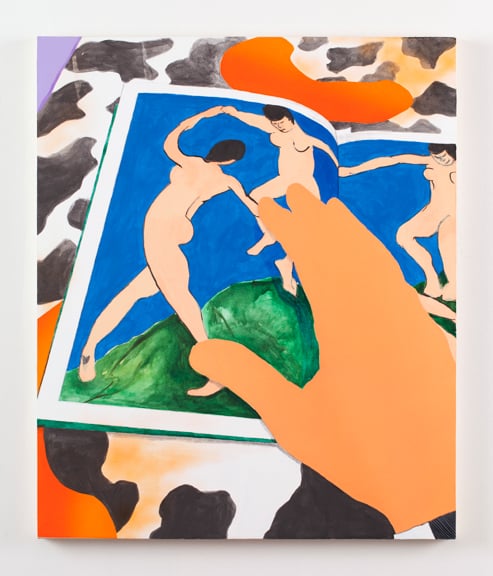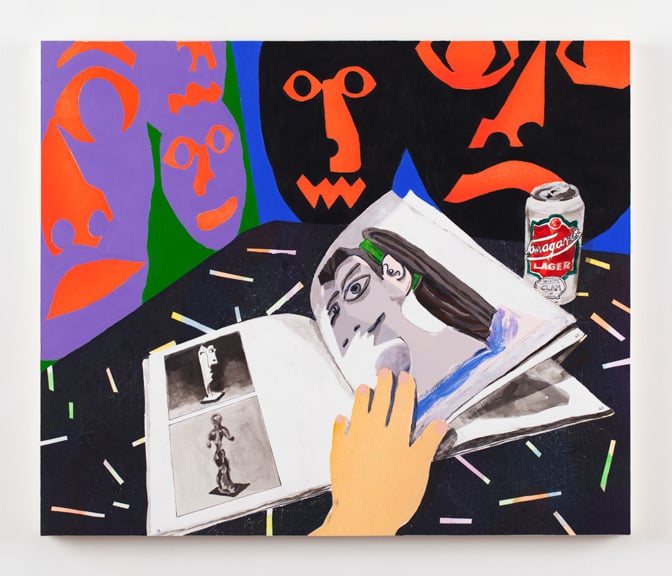Karen Lederer
Karen in her Brooklyn studio
Karen Lederer (b. 1986, New York, NY) received her BFA in Printmaking and Drawing from the Sam Fox School of Fine Art and Design at Washington University in St. Louis in 2008 and an MFA in Printmaking from Rhode Island School of Design in 2012. She was recently a SIP Award recipient from the Robert Blackburn Printmaking Workshop Program at The Elizabeth Foundation for the Arts. Her work has been written about in the Art Business News “30 Under 30” feature, Studio Visit Magazine, and New American Paintings. She has shown recently at Field Projects Gallery in Dear You, at Projekt 722 in See-Through, and Low Road Gallery in Cross Pollination. She works out of her studio in Crown Heights, Brooklyn.
Statement
My work comes out of yards of Marimekko fabric, Matisse still-life paintings, household objects, Picasso ceramics, print advertisements, Instagram aesthetics, and the mediated mystery of monoprinting. Educated with a printmaking background, I bring a graphic sensibility to the work. I combine the subtle gradients of monoprinting with the gestural touch of painting. Working alongside printed areas, I define the rest of the image with paint. Both flat and rendered, the work conveys a spatial disorientation that denies stability.
My paintings portray attempts at intimacy such as plants reaching out for contact, Cheetos dust pollinating tablecloths, and a hand touching a fish through glass. Cryptic narratives emerge through the juxtaposition of patterns and objects. The work conjures up contradictory feelings of sexless desire and confident awkwardness. Fine art and design references inhabit the same environments as snack foods and beer. These symbols of art appear more pedestrian in their connection to the everyday while the mundane objects beside them grow more surreal. Captured at a close range reminiscent of an Instagram photo, the scenes depict a distinct moment in time. The anonymous hand and feet, a bit of disembodied portraiture, comes in and out of the work and asserts the presence and perspective of the artist.
Q&A with Karen Lederer
by Emily Burns
Hi Karen! Can you give us some insight into your process? How do you begin and how do you create your compositions?
My working process is generative. One painting often leads to next. For example a Matisse poster appeared in one painting, and then later I started to explore goldfish bowls, a common Matisse motif, and that lead to goldfish crackers scattered on a table in another piece. I begin by setting up a still life and then taking lots of photographs of it with my phone. I then project the chosen photograph onto paper, and plan out what elements will be printed and what will be painted.
What initially interested you about the Marimekko fabric you reference?
I don’t directly reference any Marimekko fabric, but my work definitely takes inspiration from its bold, graphic quality. I often look through books on the work of Maia Isola, painter and designer for Marimekko, and think about how pattern enriches our environment by infusing whimsy into the everyday.
Can you talk about how you employ the monoprint process along with a more direct painting process?
I am definitely a conflicted printmaker. I love the graphic, mysterious marks that only monoprinting can produce, but also appreciate the control that painting offers. For a long time I kept the processes separate. More recently I have begun to combine the two. When I make a drawing, I plan out what areas I want to be completed with printmaking. Usually these sections tend to be either super flat, have a color gradient, or a strange texture. I cut individual foam plates for all of these elements. After I print those plates, I fix the paper onto a panel and complete the rest of piece with paint. I enjoy the challenge of making highly rendered areas sit well next to others that are flat and graphic.
Can you elaborate on the Instagram aesthetic that you mention in your statement? How do you think social media platforms like Instagram affect they way communicate today? Is this different for artists or creative types?
All of the photographs I take for my compositions are shot with my iPhone at a close range. If a hand is in the photo, it’s my hand. Just like an Instagram photo, there’s a self-conscious quality in the painting because the point of view of the creator is so present. Later an image of the final painting appears on my Instagram page. I think this social media platform suits artists particularly well because it’s so visual. Each profile presents a different gallery of images open to critique and discussion.
You also mention how your work, “both flat and rendered, conveys a spatial disorientation that denies stability.” I definitely get a sense of this when looking at your images. Some of the areas appear to be collaged onto the support, with a hairline border of around the edges. For me, this really adds to the spatial disorientation. Is there a collage element to your work or is this an effect of the mono printing? Are you referencing a digital sensation as well?
That thin border around the edges is a result of my printing process. Because the foam plates that I print with are quite thick, they leave a halo around the image. I keep that in the final piece in order to create a subtle disruption of the space. I like the visual trick that the painting feels collaged but is actually one continuous surface. The plates are also cut by hand with scissors. The uneven edges and slight imperfections heighten the collage aesthetic and also affirm the flatness of the object. Both the glowing halos and color gradients definitely reference a digital sensation. The compositions begin with photography so it makes sense that that digital aesthetic would reappear later in the final image.
You are currently a printshop manager in Tara Donovan’s studio. What is that experience like?
I have worked for Tara for a long time. I first met her when I was interning at Pace Prints, so it was thrilling to be able to make a series of prints for her. Now that the series is done, I’m back to fabricating sculptures with the rest of the studio.
What is a typical day like for you?
My week is filled with pretty different activities. Some days I go to Tara’s studio and make materials for sculptures, and then go to my own studio to work on my art. Some days I teach children at the Brooklyn Museum. The few days I can dedicate entirely to my studio practice feel very special and important.
Can you describe your studio space? What are your most important workspace essentials?
I share my studio with three other artists. My space is tucked in the corner of the room. It’s a little on the dark side, but I love it. I’ve realized how much location is important to me. My current space is a short walk from my apartment. I think about what I want to accomplish on my way over, and once I arrive I’m in the right headspace. My workspace essentials are speakers, projector, brushes, paint, and hopefully one day a window.
What do you listen to while you work? Is this an important part of your practice?
I have an old iPod in my studio that I always put on shuffle. I haven’t updated it since college, so it has a really odd mix of music on it. I’ve listened to each song a million times. I need the pure background noise to help me zone out, but I don’t really focus on it at all.
What are you reading right now?
At my day job I listen to audiobooks. I just finished Stacy Schiff’s The Witches. At home I’m reading Vladimir Nabokov’s Pnin. I borrowed a copy of it from dad. Once in a while I’ll come across pencil annotations from when he read it, and it makes the book feel even richer.
What are some of the artists that you look at feel that your work is in dialogue with?
It’s not a big surprise that I love color, and I am generally interested in artists with the same tendency. I feel my work is in dialogue with the work of Polly Apfelbaum, Tom Wesselmann, David Hockney, and Jonas Wood. I’ve been continually fascinated by the art of Pablo Picasso and Henri Matisse and by the conversation between their works. Many of my pieces feature Picasso ceramics and reproductions of Matisse and Picasso artwork in books. I construct my relationship to art history and highlight the chain of influence between these artistic giants and me.
Do you have any advice for recent grads that are looking for teaching jobs, transitioning out of graduate school, or looking to begin their career as studio artists?
When I got out of grad school I realized that I was living in a bubble for two years. It was important for me to reconnect with people outside of my field. Those people keep me grounded. I also found it helpful to participate in a critique group with friends. In grad school I talked about my work non‐stop, but now those moments are more spread out and have become extremely important. In terms of work, apply to everything and don’t take any rejection too seriously.
What is your experience of the artist community in Brooklyn?
The artist community in Brooklyn is vibrant. There are so many people making work and trying to put themselves out there. I am lucky to have a lot of friends from RISD around. We visit one another’s studios and attend openings together and that makes the whole situation a lot friendlier.
Do you have any exciting news or shows coming up?
I’ll be showing one of my monoprints at the International Print Center New York this Winter. I’m also preparing for a show this summer at the 20/20 Gallery which highlights work from and since the Studio Immersion Project Fellowship at Robert Blackburn Printmaking Workshop Program.
Thanks so much for sharing your work and talking with us!
To find out more about Karen and her work, check out her website.













